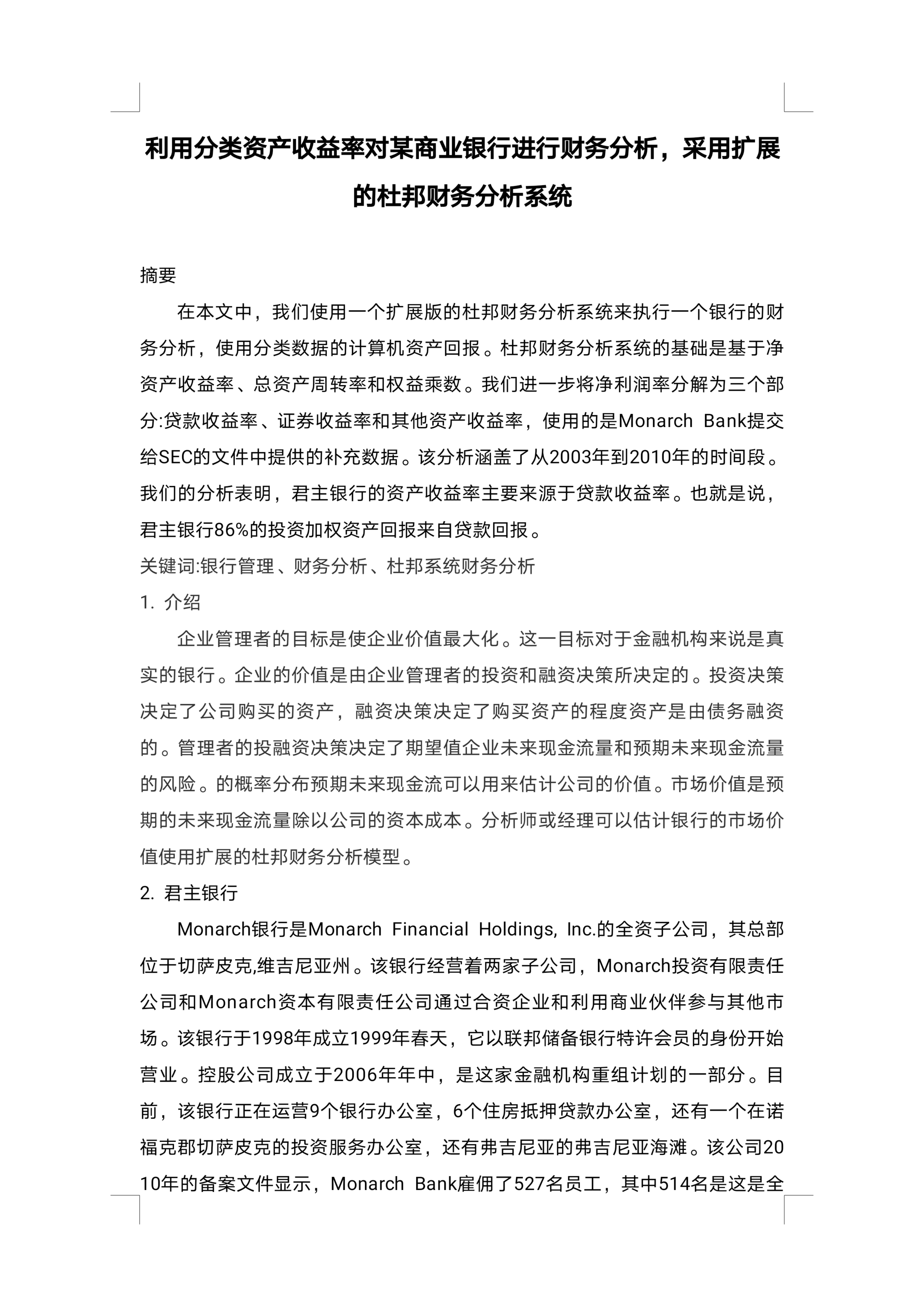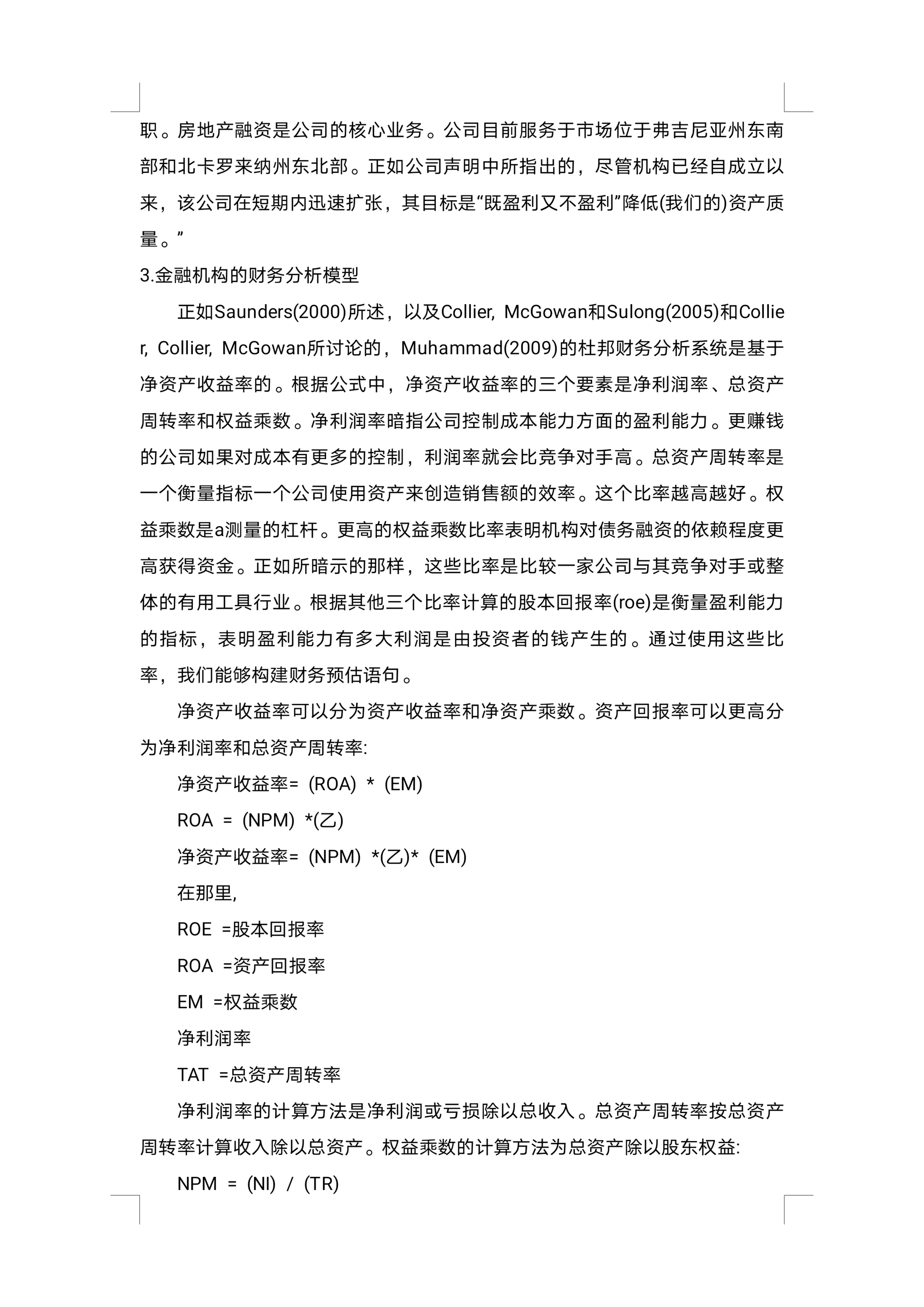附录A 外文原文
Using Disaggregated Return on Assets to Conduct a Financial Analysis ofa Commercial Bank Using an Extension of the DuPont System of FinancialAnalysis
Abstract
In this paper, we use an expanded version of the DuPont system of financial analysis to perform a financial analysis of a bank using disaggregated data to computer return on assets. The DuPont system of financial analysis is based on return on equity which is based on net profit margin, total asset turnover, and the equity multiplier. We further disaggregate net profit margin into three components: return on loans, return on securities, and return on other assets using supplementary data provided in the SEC filings of Monarch Bank. The analysis covers the period from 2003 to 2010. Our analysis demonstrates that return on assets for Monarch Bank derives primarily from return on loans. That is, 86% of the investment weighted return on assets for Monarch Bank derives from return on loans. Keywords: Bank management, Financial analysis, DuPont system of financial analysis
- Introduction
The goal of corporate managers is to maximize the value of the firm. This goal is true for financial institutions such as banks. The value of the firm is determined by the investment and financing decisions made by the managers of the firm. Investment decisions determine the assets bought by the firm and financing decisions determine the extent to which assets are financed with debt. The investment and financing decisions made by managers determine the expected value of future cash flows of the firm and the riskiness of those expected future cash flows. The probability distribution of expected future cash flows can be used to estimate the value of the firm. The market value is the expected future cash flow divided by the cost of capital for the firm. The analyst or manager can estimate the market value of the bank using the expanded DuPont model of financial analysis.
- Monarch Bank
Monarch bank is the wholly-owned subsidiary of Monarch Financial Holdings, Inc. whose headquarters is located in Chesapeake, Virginia. The bank operates two subsidiaries, Monarch Investment, LLC and Monarch Capital, LLC and participates in other markets through joint ventures and the use of business partners. The bank incorporated in 1998 and opened its doors to business as a chartered member of the Federal Reserve Bank in the spring of 1999. The holding company was created mid-2006 as part of a reorganization plan for the financial institution. Currently, the bank operates nine banking offices, six residential mortgage offices, and a single investment services office in Chesapeake, Norfolk, and Virginia Beach, Virginia. The companys 2010 filings indicate that Monarch Bank employs 527 individuals, 514 of which are full-time. Real estate financing comprises Monarchs core business. The company currently serves the markets of southeastern Virginia and Northeastern North Carolina. As noted in company statements, although the institution hasquickly expanded over the short period since its founding, the company aims 'to do so profitably and withoutcompromising (our) asset quality.'
3. A Financial Analysis Model for Financial Institutions
As presented in Saunders (2000) and discussed in Collier, McGowan, and Sulong (2005) and Collier, Collier, McGowan,and Muhammad (2009), the DuPont system of financial analysis is one based on return on equity. According to theformula, the three elements of return on equity are net profit margin, total asset turnover, and the equity multiplier. Netprofit margin alludes to a companys profitability in regards to their ability to control costs. A more profitable companywith more control over costs would exhibit a profit margin higher than competitors. Total Asset Turnover is a measureof a companys efficiency in using assets to generate sales. The higher that this ratio the better. The equity multiplier is ameasure of leverage. A higher equity multiplier ratio shows that an institution is relying more heavily on debt financingto obtain funds. As implied, these ratios can be useful tools in comparing a company to its competitors or overallindustry. Return on equity, as computed from the other three ratios, is a measure of profitability, suggesting how muchprofit is being generated with investorsrsquo; money. Through use of these ratios, we are able to construct pro forma financialstatements.
Return on equity can be split into return on assets and the equity multiplier. Return on assets can be furtherdisaggregated into net profit margin and total asset turnover:
ROE = (ROA)*(EM)
ROA= (NPM)*(TAT)
ROE = (NPM)*(TAT)*(EM)
Where,
ROE = Return on Equity
ROA = Return on Assets
EM = Equity Multiplier
NPM = Net Profit Margin
TAT = Total Asset Turnover
Net profit margin is calculated as net profit or loss divided by total revenue. Total asset turnover is calculated as total
revenue divided by total assets. The equity multiplier is calculated as total assets divided by total stockholdersrsquo; equity:
NPM = (NI) / (TR)
TAT = (TR) / (TA)
EM = (TA) / (TSE)
Where,
NPM = Net Profit Margin
NI = Net Income
TR = Total Revenue
TAT = Total Asset Turnover
TA = Total Assets
EM = Equity Multiplier
TSE = Total Stockholdersrsquo; Equity
4. Further Disaggregation of DuPont as Applies to Financial Institutions
Banks differ significantly from other institutions to which the DuPont system of financial analysis is applied. Loansmake up the vast majority of a banks assets, and interest on these holdings comprise a large proportion of total incomefor the typical bank. Furthermore, owners equity composes merely ten percent of the institutions liabilities.Consequently, the principal struggle in banking involves balancing the objectives of solvency and liquid
剩余内容已隐藏,支付完成后下载完整资料


英语译文共 7 页,剩余内容已隐藏,支付完成后下载完整资料
资料编号:[605426],资料为PDF文档或Word文档,PDF文档可免费转换为Word


